
Plano inclinado [Inclined plane]
solo show at Sim Galeria
Curitiba2017
"If you can look, see. If you can see, notice"
J. Saramago
"Mud, salt crystals, rocks, water"
R. Smithson
Although there are no concrete accounts of the beginnings of painting, it is known that painting was born “in the negative”. Pliny the Elder, in his Natural History, tells us the episode of a young woman, the daughter of an artificer from Corinth (Greece) who, in love with a young man about to leave the city, would have fixed by lines the profile of the lover projected on the wall by the light of a lamp.
Perhaps one of the most uncertain and mysterious episodes in the history of art, in which everything is about conjectures, in it becomes concrete much of what we still understand today as “image”: between presence and absence, simulacrum and substitution.
If the shadow is the origin of the painting, the negative is the origin of the photograph, which, centuries later, adds a new ontological possibility: an image is also the material vestige of a referent, “trace” or “index”.
These two “origin myths” come to me, separated from each other, due to what Marcelo Moscheta presents in “Plano Inclinado” [“Inclined Plane”], his second solo exhibition at SIM Galeria. Not because it is an exhibition that deals with specific disciplines, but rather because the proposal that Moscheta brings us is part of a postmodern exercise of sculpture, that is, the overcoming of discipline and the idea that it is possible to perform all modalities of the artistic procedure, even those that belong to another domain, the anthropological, the documentary, the mere collection, the inventory, the archive, the cinematic.
A laboratory of contemporary art, called “art-as-thing-without-name” by some authors, sculpture has developed in the last century by several other ways that make its status a permanent place of negotiation. The film, the video and the photography have added the possibility of not ceasing to be a sculpture, but also being able to be an object and an installation, to be organized on the fictional plane, to address the deferred, the absence and the non-representation.
J. Saramago
"Mud, salt crystals, rocks, water"
R. Smithson
Although there are no concrete accounts of the beginnings of painting, it is known that painting was born “in the negative”. Pliny the Elder, in his Natural History, tells us the episode of a young woman, the daughter of an artificer from Corinth (Greece) who, in love with a young man about to leave the city, would have fixed by lines the profile of the lover projected on the wall by the light of a lamp.
Perhaps one of the most uncertain and mysterious episodes in the history of art, in which everything is about conjectures, in it becomes concrete much of what we still understand today as “image”: between presence and absence, simulacrum and substitution.
If the shadow is the origin of the painting, the negative is the origin of the photograph, which, centuries later, adds a new ontological possibility: an image is also the material vestige of a referent, “trace” or “index”.
These two “origin myths” come to me, separated from each other, due to what Marcelo Moscheta presents in “Plano Inclinado” [“Inclined Plane”], his second solo exhibition at SIM Galeria. Not because it is an exhibition that deals with specific disciplines, but rather because the proposal that Moscheta brings us is part of a postmodern exercise of sculpture, that is, the overcoming of discipline and the idea that it is possible to perform all modalities of the artistic procedure, even those that belong to another domain, the anthropological, the documentary, the mere collection, the inventory, the archive, the cinematic.
A laboratory of contemporary art, called “art-as-thing-without-name” by some authors, sculpture has developed in the last century by several other ways that make its status a permanent place of negotiation. The film, the video and the photography have added the possibility of not ceasing to be a sculpture, but also being able to be an object and an installation, to be organized on the fictional plane, to address the deferred, the absence and the non-representation.
Therefore, it is possible that we are mistaken if we look at the work of Marcelo Moscheta from the clinical and mineral rigor that brings him closer to the exact sciences. Since we are only looking at this “exteriority”, we will fail to observe how close it is to this eroticism of the beginnings, the memory of an absent body which Pliny the Elder has told us about. In short, we will fail to see a significant aspect that is the operation of the “imaginary”, this “cannibalistic treat that transforms the real”, that instigated so much Freud.
In general, the work of Moscheta operates in this dialectic or tension, and I believe that a single work of this exposition is able to speak for all this complexity, just as a stone can speak about the geological landscape to which it belongs.
Entitled “Memória Gráfica” [“Graphic Memory”], in reference to the set of lithographic stones that the artist found broken irregularly in its edges. It is an installation that occupies a prominent space of the gallery and organizes around it all the other works.
The idea that gives us is that through the fragments we can mentally compose a small imaginary mountain range of “full” and “hollow” elements, in an artistic operation that unites the drawing to the object as part of the same linguistic system. The dynamism that it confers to space relates not only to this operation, but also to an idea of origin and final destination, of us, of the world.
As Moscheta says, “this work wants to transform the memory contained in the surface of the stone, which once was the cradle of innumerable reproductions, in a new and last black print. It continues accumulating images in layers and more layers, like a palimpsest of all the previous ones. A cyclical game between the ideas of reproduction and origin”.
The drawing of a graphite on a black background rebounds and multiplies the mental horizon of the exhibition as a “projection surface” on which the meticulousness of the formal arrangement opens up for a deliberate alienation of expressive possibility and even removes the cognitive dimension of the technique.
This sensitivity of Marcelo Moscheta’s work, in which its conceptual legacy is crossed by the problematic feeling of its own historicity - because the present does not add up or deposit memory - becomes here an exercise of going back and forth. This movement perpetually remakes our erotic relation to the image, between presence and absence.
Marta Mestre
September 2017
In general, the work of Moscheta operates in this dialectic or tension, and I believe that a single work of this exposition is able to speak for all this complexity, just as a stone can speak about the geological landscape to which it belongs.
Entitled “Memória Gráfica” [“Graphic Memory”], in reference to the set of lithographic stones that the artist found broken irregularly in its edges. It is an installation that occupies a prominent space of the gallery and organizes around it all the other works.
The idea that gives us is that through the fragments we can mentally compose a small imaginary mountain range of “full” and “hollow” elements, in an artistic operation that unites the drawing to the object as part of the same linguistic system. The dynamism that it confers to space relates not only to this operation, but also to an idea of origin and final destination, of us, of the world.
As Moscheta says, “this work wants to transform the memory contained in the surface of the stone, which once was the cradle of innumerable reproductions, in a new and last black print. It continues accumulating images in layers and more layers, like a palimpsest of all the previous ones. A cyclical game between the ideas of reproduction and origin”.
The drawing of a graphite on a black background rebounds and multiplies the mental horizon of the exhibition as a “projection surface” on which the meticulousness of the formal arrangement opens up for a deliberate alienation of expressive possibility and even removes the cognitive dimension of the technique.
This sensitivity of Marcelo Moscheta’s work, in which its conceptual legacy is crossed by the problematic feeling of its own historicity - because the present does not add up or deposit memory - becomes here an exercise of going back and forth. This movement perpetually remakes our erotic relation to the image, between presence and absence.
Marta Mestre
September 2017


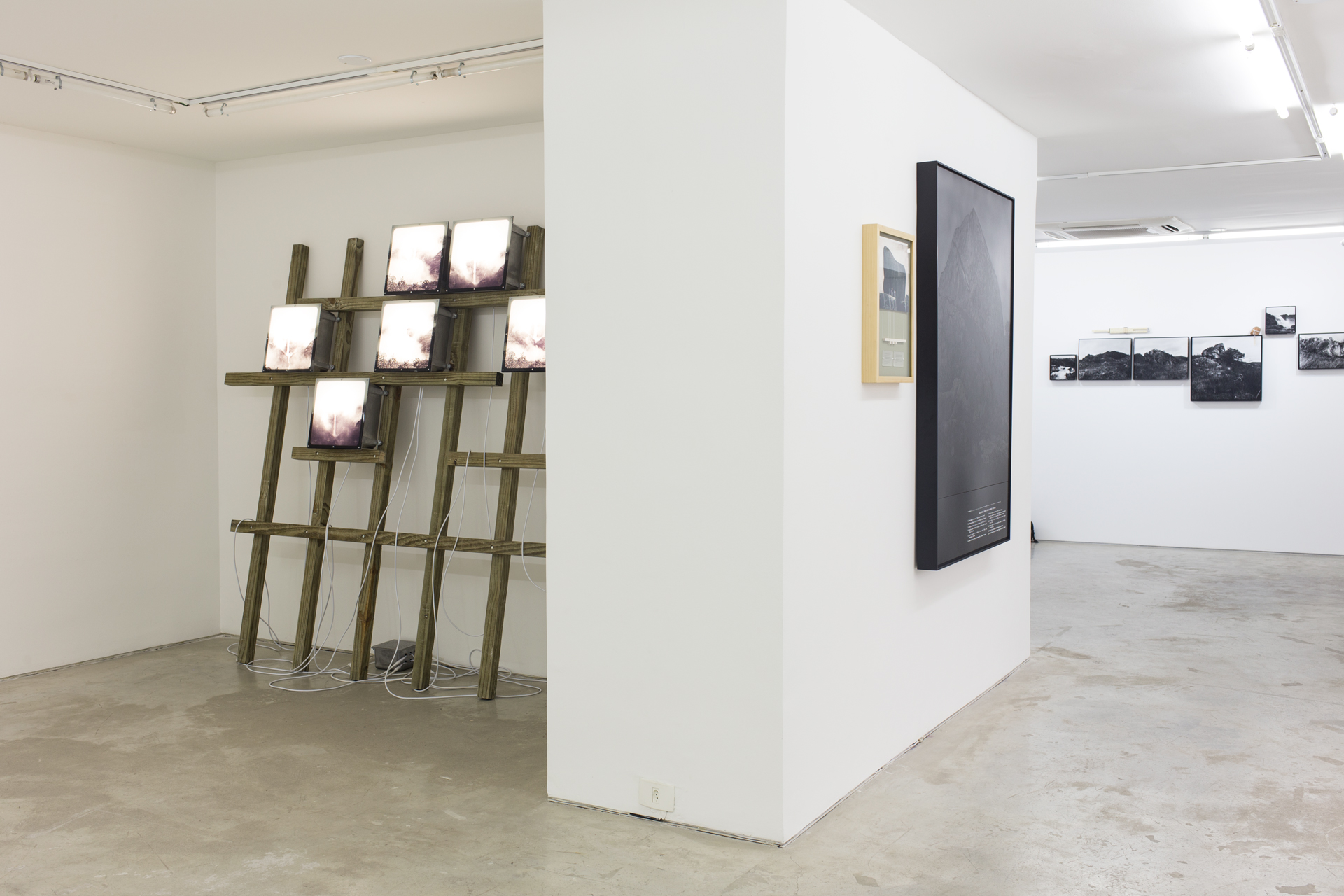
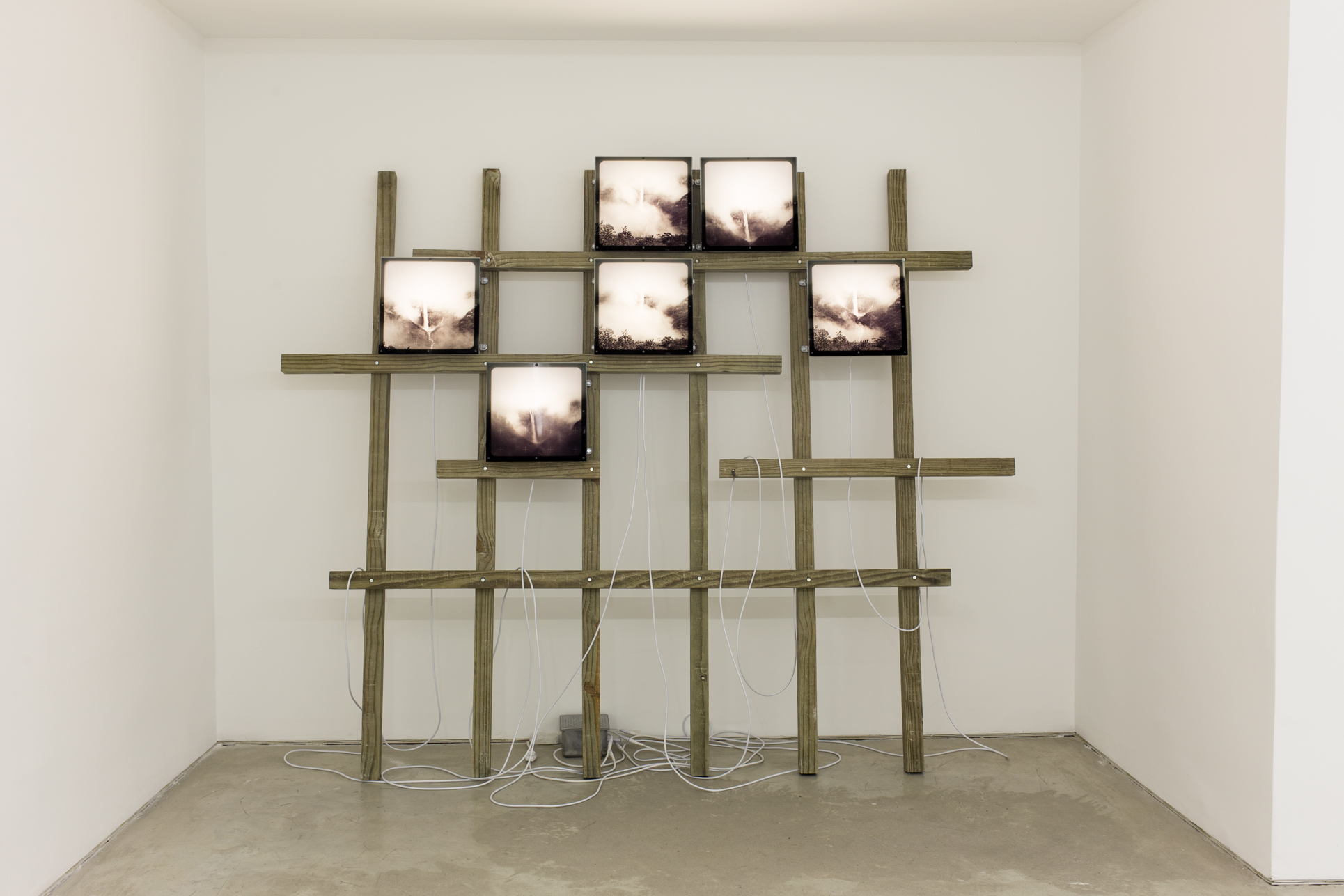


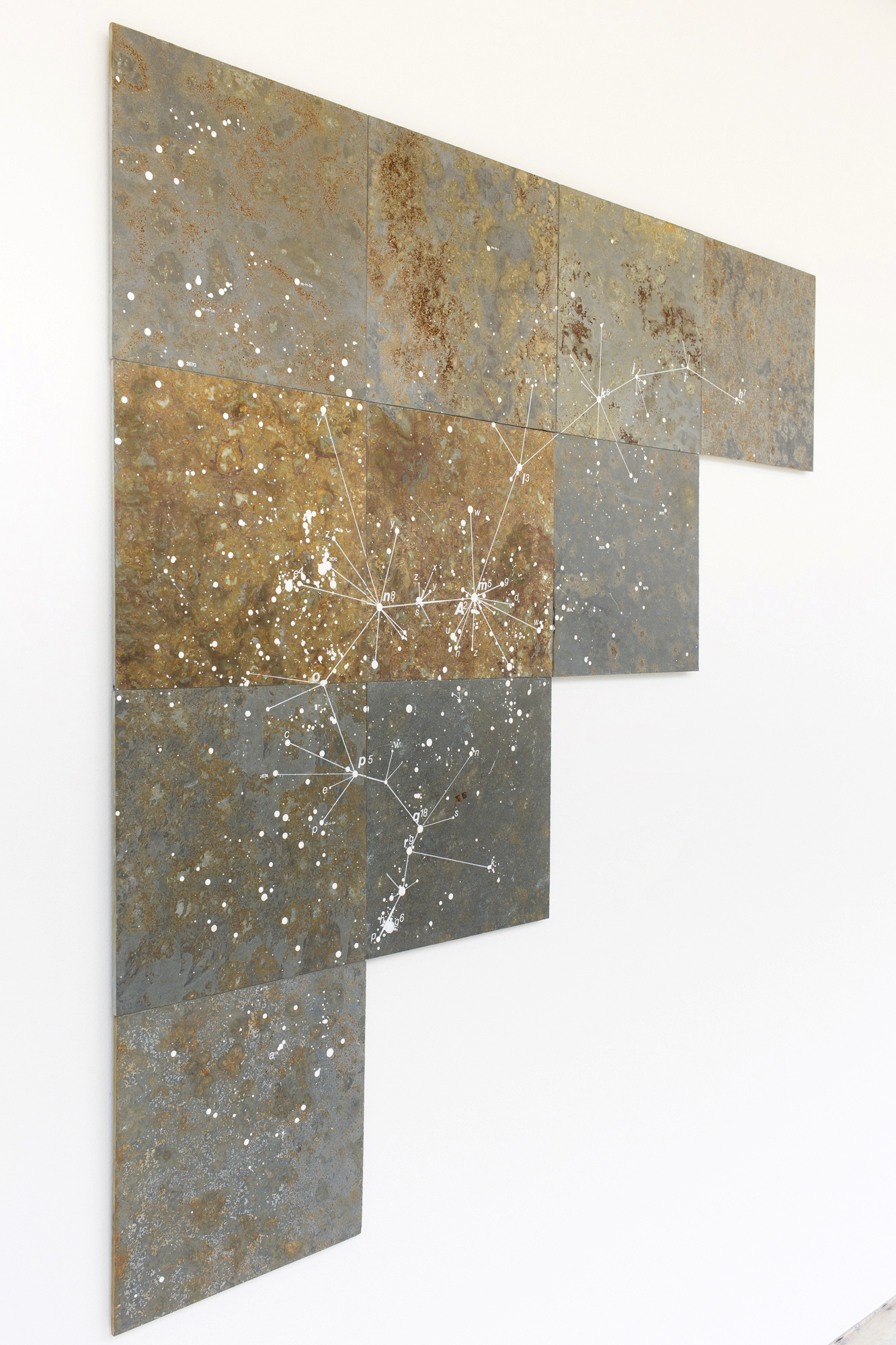
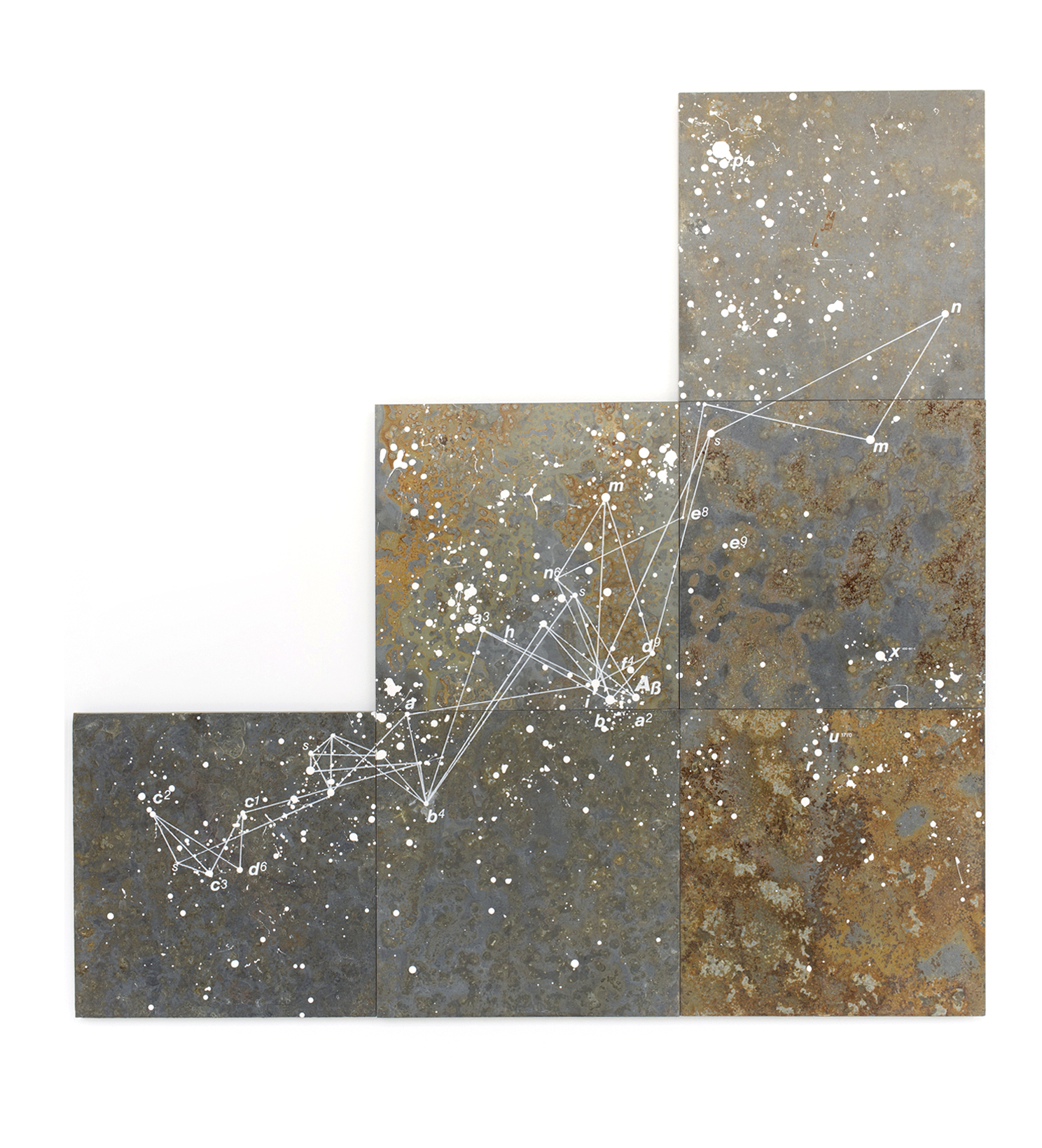

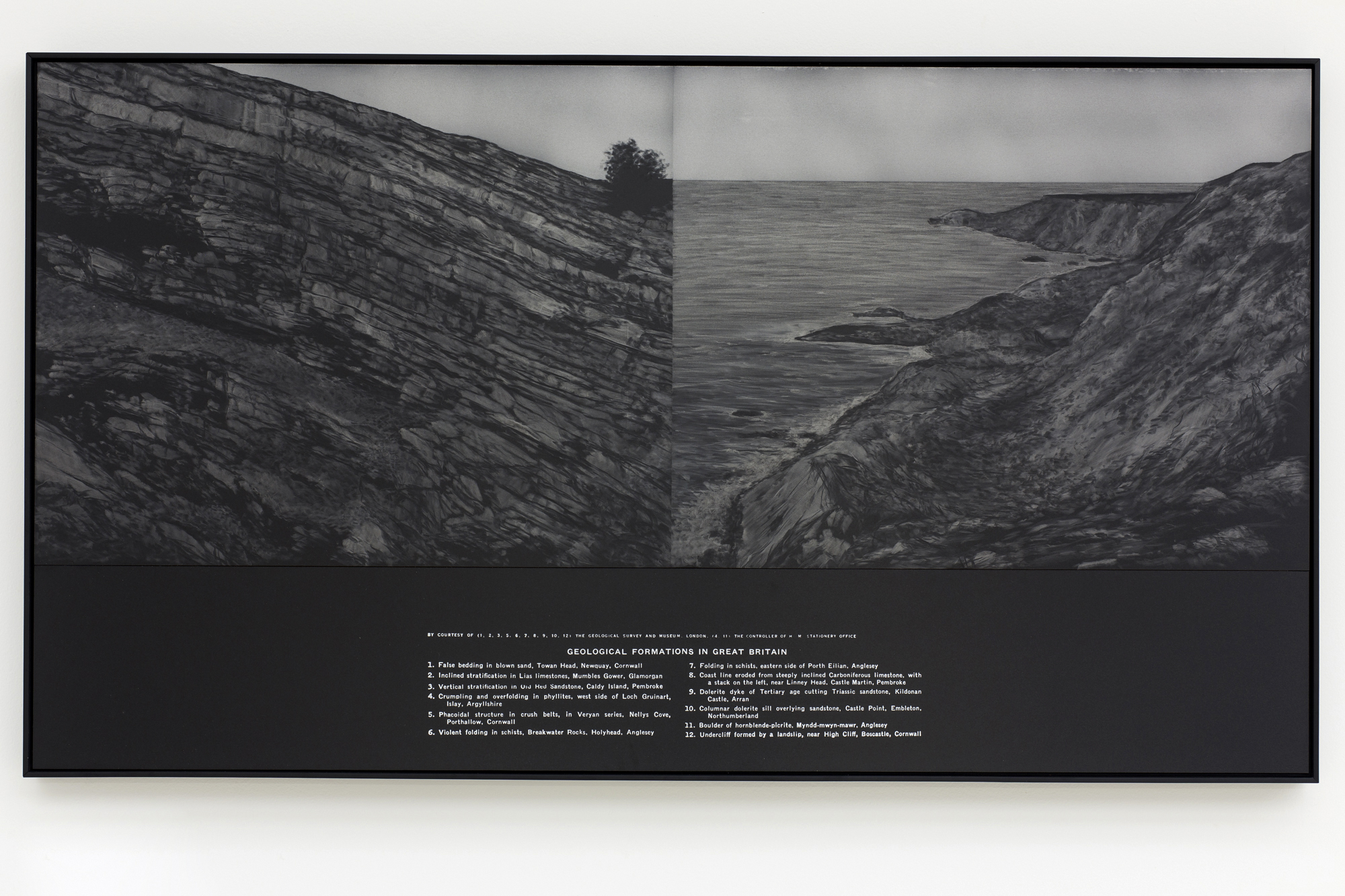
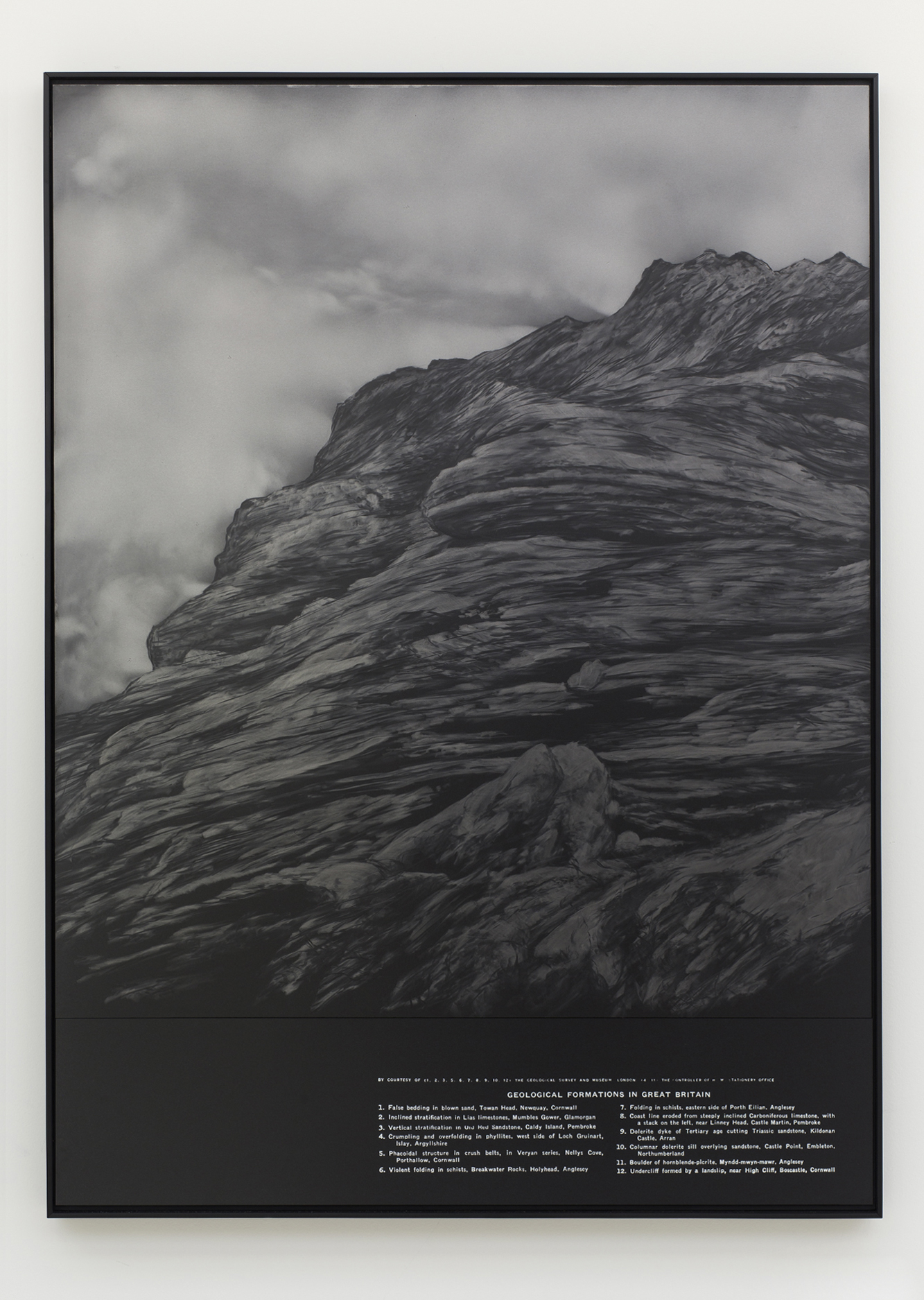


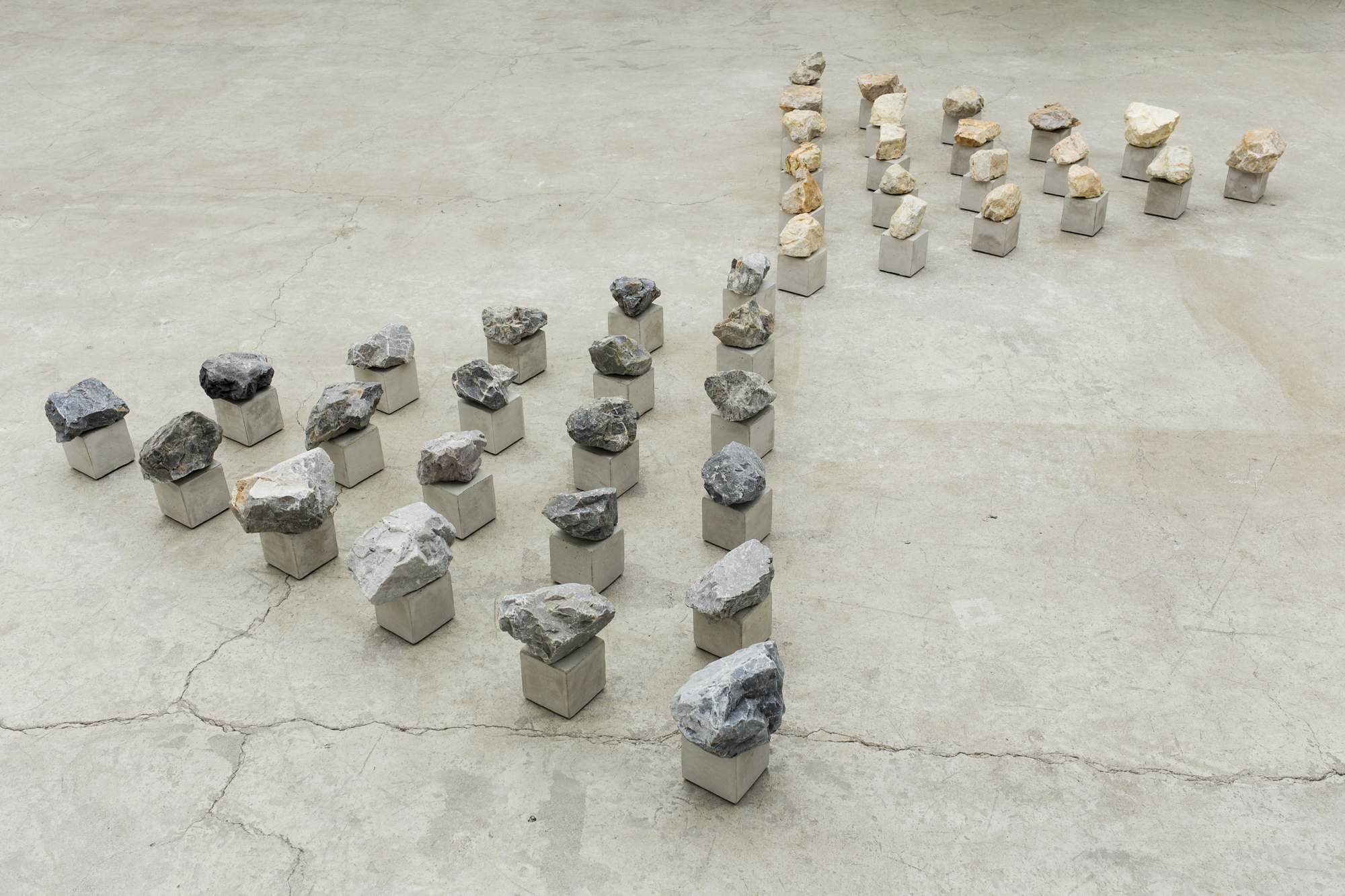

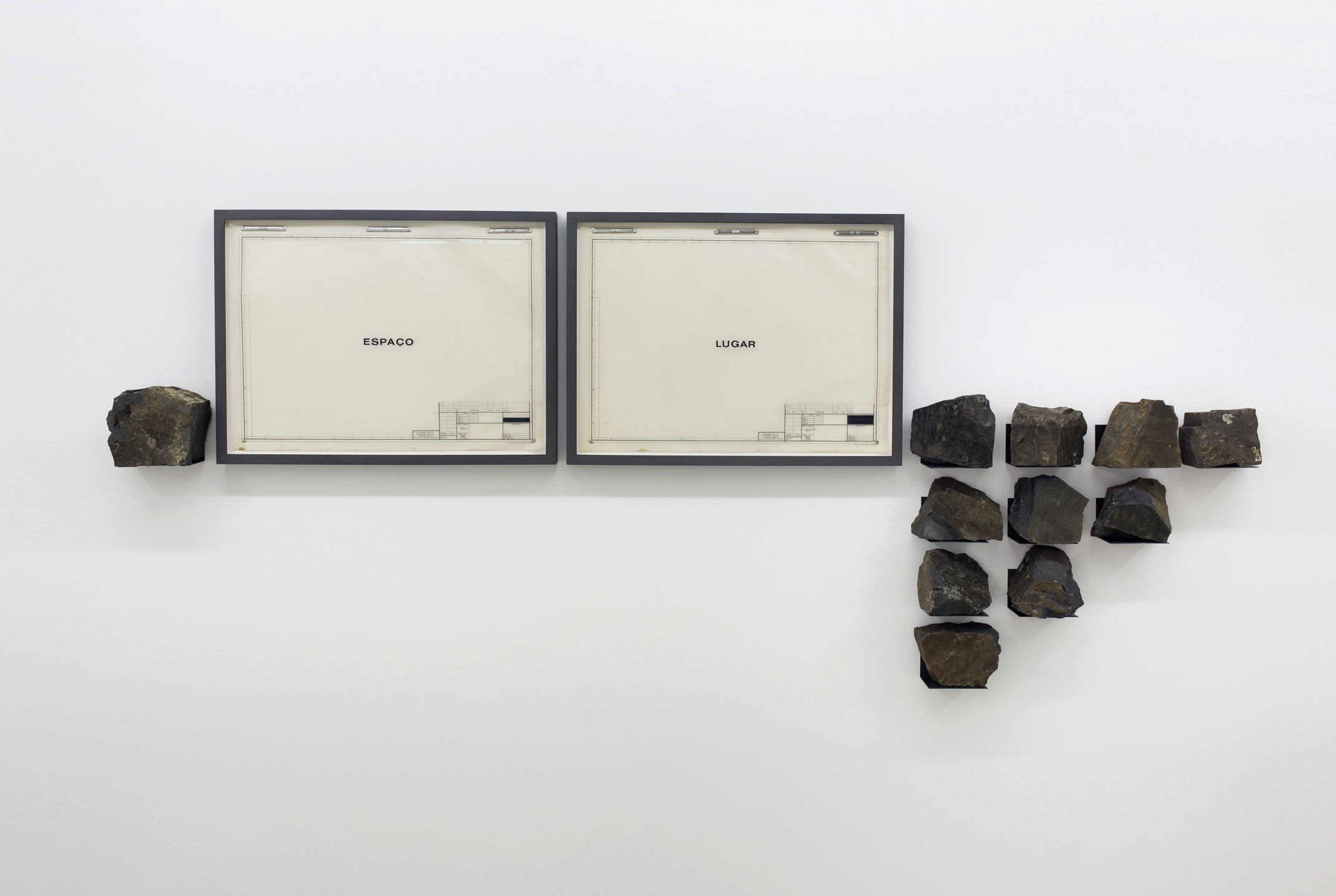
[photos Rafael Dabul]
Plano inclinado
exposição individual na Sim Galeria
Curitiba2017
"Se puderes olhar, vê. Se puderes ver, repara"
J. Saramago
"Lama, cristais de sal, rocha, água"
R. Smithson
Embora não existam relatos concretos sobre os primórdios da pintura, sabe-se que esta nasce “em negativo”. Plínio, o Velho, em sua “História Natural”, conta-nos o episódio de uma jovem, filha de um artífice de Corinto (Grécia) que, enamorada por um rapaz prestes a deixar a cidade, teria fixado por meio de linhas, o perfil do amante projetado na parede, à luz de uma candeia.
Constituindo talvez um dos mais incertos e misteriosos episódios da história da arte, onde tudo se presta a conjecturas, nele se concretiza muito daquilo que ainda hoje entendemos por “imagem”: entre presença e ausência, simulacro e substituição.
Se a sombra está na origem da pintura, o negativo está na origem da fotografia, a qual, séculos mais tarde, acrescenta uma nova possibilidade ontológica: uma imagem é também vestígio material de um referente, “traço” ou “índice”.
Ocorrem-me estas duas “narrativas da origem”, afastadas entre si, a propósito do que Marcelo Moscheta nos apresenta em “Plano Inclinado”, a sua 2a exposição individual na SIM Galeria. Não por se tratar de uma exposição que versa sobre disciplinas específicas, antes pelo contrário, a proposta que Moscheta nos traz radica no exercício pós-moderno da escultura, isto é, a superação da disciplina e a ideia de que é possível realizar todas as modalidades possíveis do procedimento artístico, mesmo aquelas que pertencem a outro domínio, do antropológico, do documental, da mera recolecção, inventariação, do arquivo, do cinemático.
Laboratório de ensaio da arte contemporânea, a que alguns autores chamam de “arte-como-coisa-sem-nome”, a escultura desenvolveu-se no último século por várias outras vias que tornam o seu estatuto um lugar permanente de negociação. O filme, o vídeo e a fotografia agregaram-lhe a possibilidade de não deixar de ser escultura, mas poder ser também objeto e instalação, de se organizar no plano ficcional, abordar o diferido, a ausência e a não- representação.
J. Saramago
"Lama, cristais de sal, rocha, água"
R. Smithson
Embora não existam relatos concretos sobre os primórdios da pintura, sabe-se que esta nasce “em negativo”. Plínio, o Velho, em sua “História Natural”, conta-nos o episódio de uma jovem, filha de um artífice de Corinto (Grécia) que, enamorada por um rapaz prestes a deixar a cidade, teria fixado por meio de linhas, o perfil do amante projetado na parede, à luz de uma candeia.
Constituindo talvez um dos mais incertos e misteriosos episódios da história da arte, onde tudo se presta a conjecturas, nele se concretiza muito daquilo que ainda hoje entendemos por “imagem”: entre presença e ausência, simulacro e substituição.
Se a sombra está na origem da pintura, o negativo está na origem da fotografia, a qual, séculos mais tarde, acrescenta uma nova possibilidade ontológica: uma imagem é também vestígio material de um referente, “traço” ou “índice”.
Ocorrem-me estas duas “narrativas da origem”, afastadas entre si, a propósito do que Marcelo Moscheta nos apresenta em “Plano Inclinado”, a sua 2a exposição individual na SIM Galeria. Não por se tratar de uma exposição que versa sobre disciplinas específicas, antes pelo contrário, a proposta que Moscheta nos traz radica no exercício pós-moderno da escultura, isto é, a superação da disciplina e a ideia de que é possível realizar todas as modalidades possíveis do procedimento artístico, mesmo aquelas que pertencem a outro domínio, do antropológico, do documental, da mera recolecção, inventariação, do arquivo, do cinemático.
Laboratório de ensaio da arte contemporânea, a que alguns autores chamam de “arte-como-coisa-sem-nome”, a escultura desenvolveu-se no último século por várias outras vias que tornam o seu estatuto um lugar permanente de negociação. O filme, o vídeo e a fotografia agregaram-lhe a possibilidade de não deixar de ser escultura, mas poder ser também objeto e instalação, de se organizar no plano ficcional, abordar o diferido, a ausência e a não- representação.
Posto isto, é possível que nos equivoquemos se olharmos para o trabalho de Marcelo Moscheta a partir do rigor clínico e mineral que o aproxima das ciências exatas. Porque atentando somente para esta “exterioridade”, deixaremos de observar o quanto está próximo dessa erótica dos primórdios, memória de um corpo ausente, de que nos falava Plínio, O Velho. Em suma, deixaremos de enxergar um aspeto significativo que é a operação do “imaginário”, essa “guloseima canibal que transforma o real”, que tanto instigou Freud.
De um modo geral, o trabalho de Moscheta opera nesta dialética ou tensão, e julgo que um único trabalho desta exposição é capaz de falar por toda esta complexidade, da mesma forma que uma pedra pode falar sobre a paisagem geológica a que pertence.
Intitulado “Memória Gráfica”, em referência ao conjunto de pedras litográficas que o artista encontrou quebradas de modo irregular nas suas bordas, trata-se de uma instalação que ocupa um espaço destacado da galeria, e organiza à sua volta todos os trabalhos restantes.
A ideia que nos dá, é que através dos fragmentos podemos compor mentalmente uma pequena cordilheira imaginária de “cheios” e “vasados”, numa operação artística que une o desenho ao objeto, como parte de um mesmo sistema linguístico. O dinamismo que confere ao espaço, relaciona-se não apenas a esta operação, mas também a uma ideia de origem e destino final, de nós, do mundo.
Como refere Moscheta “este trabalho procura transformar a memória contida na superfície da pedra, que um dia foi berço de inúmeras reproduções, em uma nova e última estampa, negra. Segue acumulando imagens em camadas e mais camadas, como que um palimpsesto de todas as anteriores. Um jogo cíclico entre a ideia de reprodução e de origem”.
O desenho de grafite sobre um fundo negro, rebate e multiplica o horizonte mental da exposição, como uma “superfície de projeção” onde a meticulosidade do arranjo formal abre para uma deliberada alienação da possibilidade expressiva, e destitui inclusive a dimensão cognitiva da técnica.
Esta sensibilidade do trabalho de Marcelo Moscheta, em que o legado conceitual é atravessado pelo sentimento problemático da sua própria historicidade - porque o presente não se adensa nem deposita memória -, torna-se aqui um exercício de ir e voltar. É este movimento que perpetuamente refaz a nossa relação erótica com a imagem, entre presença e ausência.
Marta Mestre
Setembro, 2017
De um modo geral, o trabalho de Moscheta opera nesta dialética ou tensão, e julgo que um único trabalho desta exposição é capaz de falar por toda esta complexidade, da mesma forma que uma pedra pode falar sobre a paisagem geológica a que pertence.
Intitulado “Memória Gráfica”, em referência ao conjunto de pedras litográficas que o artista encontrou quebradas de modo irregular nas suas bordas, trata-se de uma instalação que ocupa um espaço destacado da galeria, e organiza à sua volta todos os trabalhos restantes.
A ideia que nos dá, é que através dos fragmentos podemos compor mentalmente uma pequena cordilheira imaginária de “cheios” e “vasados”, numa operação artística que une o desenho ao objeto, como parte de um mesmo sistema linguístico. O dinamismo que confere ao espaço, relaciona-se não apenas a esta operação, mas também a uma ideia de origem e destino final, de nós, do mundo.
Como refere Moscheta “este trabalho procura transformar a memória contida na superfície da pedra, que um dia foi berço de inúmeras reproduções, em uma nova e última estampa, negra. Segue acumulando imagens em camadas e mais camadas, como que um palimpsesto de todas as anteriores. Um jogo cíclico entre a ideia de reprodução e de origem”.
O desenho de grafite sobre um fundo negro, rebate e multiplica o horizonte mental da exposição, como uma “superfície de projeção” onde a meticulosidade do arranjo formal abre para uma deliberada alienação da possibilidade expressiva, e destitui inclusive a dimensão cognitiva da técnica.
Esta sensibilidade do trabalho de Marcelo Moscheta, em que o legado conceitual é atravessado pelo sentimento problemático da sua própria historicidade - porque o presente não se adensa nem deposita memória -, torna-se aqui um exercício de ir e voltar. É este movimento que perpetuamente refaz a nossa relação erótica com a imagem, entre presença e ausência.
Marta Mestre
Setembro, 2017